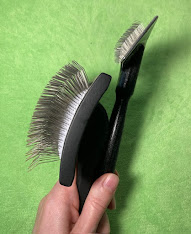Tips & Tricks for Brushing Your Dog at Home
One of the most common questions I’ve received as a professional dog groomer is HOW do I brush my dog and what TOOLS do I need? This can be a little bit of a complex answer due to the nature of how different dog breeds and coats are. Below I will try and simplify not only the tools needed, but also the how and why!
Why should I brush my dog in between grooms? Isn’t that what I pay the groomer to do?
While yes, that is a portion of what you pay your groomer to complete, at-home maintenance is so very important! Professional groomers generally will wash, dry, brush, clean ears, cut nails, and (if applicable) trim their hair. Having owners brush in between grooms can help with reduced shedding, reduced tangles/matting, and better stimulated skin, leading to a moisturized coat. More importantly, they get used to the process, so it makes the visit to the groomers less scary!
Wait a minute, there are different types of brushes?
Yes! There are a TON of different brushes on the market nowadays. Choosing which one is right for your dog will depend on the coat type. Here are some of my favorite tools:
Rubber Curry or Glove:



What coat type is my stinky dog?
Smooth-coated: Pitbull, Short-haired Chihuahua, Whippet, Great Dane
Short-coated: Pug, Labrador Retriever, Beagle, Australian Cattle Dog
Medium (double-coated): Golden Retriever, Australian Shepard, Husky, Corgi
Long-/Wavy-/Curly-coated: Poodle, Shih Tzu, Cocker Spaniel, Yorkshire Terrier, Doodles
Wire-coated: Wire-haired Dachshund, Scottish Terrier, Cairn Terrier
Okay get to the point! HOW do I brush my dog?
General rules of thumb for all breeds are:
- Brush WITH the direction that the coat is laying
- Only brush on a completely dry coat, brushing wet hair can cause excessive pulling
- Start slow; use treats and keep it positive
- Be extra gentle around the face/head, stomach, and ears as these are very sensitive, thin-skinned areas
- Reduce their range of motion (put them on a table, tie a leash to something stable, etc.); this helps keep them still and mentally separates “play time” and “business time”



Wow! I like the detail you went into to answer this common question. Now, you have given away your technique.
ReplyDeleteI never have thought of any specific way of brushing my dog, but this has truly opened my eyes to some important differences between breeds and tools! I will have to test some of your suggested tools and techniques on my pup next time!
ReplyDeleteYou did a great job on this blog! I especially liked the bullet points and table telling people about how they themselves could groom their pets.
ReplyDeleteApologies, it defaulted to anonymous.
DeleteThank you for the information. I have a Cockapoo, and he likes me to groom him. I will start doing it better, thanks to your post.
ReplyDeleteI love your blog and this post—especially how you organized the info at the bottom in a tabular format. It makes the information super easy to digest. I have a big goldendoodle and honestly, I’m not great at brushing him regularly. I do all the grooming myself, but most of the time I end up shaving him down because his coat gets really matted. I’m curious—does the detangler actually work well for heavy mats?
ReplyDeleteI could have added so much more to this blog, this is the basic info because I was approaching the 500w limit. But heavy matting generally should be shaved because it 's painful to de-mat, especially a lot. My advice would be to shave him down (as you do) and then get in a routine of brushing him every other day. Your FB video explained how active you are with him, does he swim a lot? Water will tighten any little tangles very fast. I like to compare it to humans- I have long hair and if I didn't brush my hair for days it would be a snarled mess, and if I was to take a shower with those existing tangles it would just compile. If he's very active and swims a lot, it would be in his best interest to keep him on the shorter side. The correct order of brushing is lightly mist his entire body with a detangling spray, use a slicker brush first (to loosen tangles), and then use the comb (it's great for getting all the way down to the skin and catching any little tiny tangles). To answer you question, yes detangling spray absolutely does work (if its good quality), My favorite one is from Hydra and it comes in a purple bottle. Also, as seen in my video, start at the back feet and work your way up the leg moving towards the head. This is a methodical approach so that you ensure you get every inch!
DeleteNow this is going to come in handy. My cat goes through times where he sheds like crazy - maybe Ill look into getting him a de-shedding rake! Thank you for this knowledge! ^.^
ReplyDeleteThis post helped me a lot I have a golden retriever and she has been shedding like crazy.
ReplyDeleteWe have been looking for new brushes and combs to get for our dogs, specifically Bear and Tinka. The rubber curry/glove and the undercoat tool appear to be the best options for us. Great job, and thank you for sharing your knowledge on this with us!
ReplyDeleteNice details and beautiful layout to your page, pets will keep you busy.
ReplyDelete